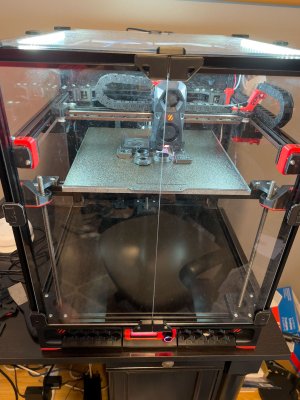- Printer Model
- Voron Trident 300
- Cooling Type
- Stealthburner
Hi Everyone,
coming from a Ender 3 S1 Pro (almost 9 months usage). Completely new to building Vorons but have been reading and watching stuff to educate myself on building one.
Planning on a Voron Trident 300x300x250 with stealth burner using BTT SB using CAN , BTT Knomi v2.0 Touch support. Want to keep the idea open for a Tridex upgrade if possible on this machine.
Right now I am struggling to understand a few thing and have these questions.
1. Can I use a Raspberry Pi 3 Model B+ or do I need a Pi 4 ?
5. which BTT EBB SB variant to pick and what are the differences , also does this choice base on what stepper drivers I pick ?
6. if I pick the BTT Octopus Max EZ then
7. Also I decided to pick the octopus series over manta series as I want to keep my Pi separate and not mount it on the controller board
any help is really appreciated.
thank you.
coming from a Ender 3 S1 Pro (almost 9 months usage). Completely new to building Vorons but have been reading and watching stuff to educate myself on building one.
Planning on a Voron Trident 300x300x250 with stealth burner using BTT SB using CAN , BTT Knomi v2.0 Touch support. Want to keep the idea open for a Tridex upgrade if possible on this machine.
Right now I am struggling to understand a few thing and have these questions.
1. Can I use a Raspberry Pi 3 Model B+ or do I need a Pi 4 ?
- the reason I prefer the Pi 3 Model B+ is I wont need a heatsink to cool.
- I have a Pi 4 and heats up a lot where as my Pi 3 Model B runs for hours without any active cooling or heatsink
- Octopus Pro v1.0 STM32F446ZE
- Octopus Pro v1.1 STM32H723ZE
- Octopus Max EZ STM32H723ZET6
- the H723 is faster compared to F446
- are EZ slots for steppers a better design and thermal dissipation compared to traditional pin based steppers ?
- TMC2209
- TMC2208 UART
- TMC5160T Pro
- is it just that one supports more voltage range over the other
- I am just lost here what is the benefit of one above the other and what to pick here
5. which BTT EBB SB variant to pick and what are the differences , also does this choice base on what stepper drivers I pick ?
- EBB SB2209
- EBB SB2240
- EBB SB2209 CAN V1.0(RP2040)
6. if I pick the BTT Octopus Max EZ then
- do I get to skip BTT U2C v2.1 CAN Adapter
- can I directly connect the CAN based stealth burner hardware directly with BTT Max EZ
7. Also I decided to pick the octopus series over manta series as I want to keep my Pi separate and not mount it on the controller board
- Is the btt octopus pro / max ez a better board compared to btt manta m8p series
- clicky probe
- voron tap , which iteration of the design to pick.
- something else
any help is really appreciated.
thank you.
Last edited:


